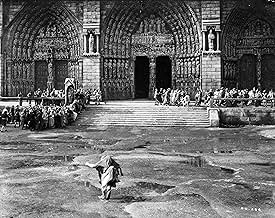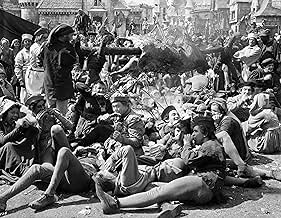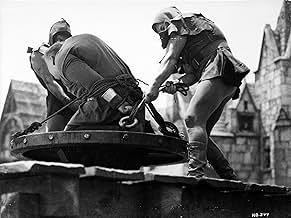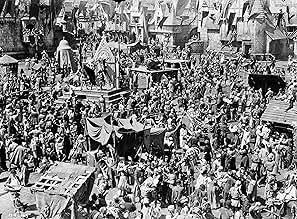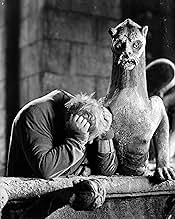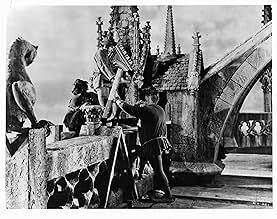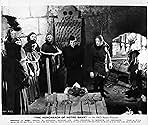IMDb रेटिंग
7.8/10
13 हज़ार
आपकी रेटिंग
अपनी भाषा में प्लॉट जोड़ेंIn 15th-century France, a gypsy girl is framed for murder by the infatuated Chief Justice, and only the deformed bellringer of Notre Dame Cathedral can save her.In 15th-century France, a gypsy girl is framed for murder by the infatuated Chief Justice, and only the deformed bellringer of Notre Dame Cathedral can save her.In 15th-century France, a gypsy girl is framed for murder by the infatuated Chief Justice, and only the deformed bellringer of Notre Dame Cathedral can save her.
- 2 ऑस्कर के लिए नामांकित
- 2 कुल नामांकन
Cedric Hardwicke
- Frollo
- (as Sir Cedric Hardwicke)
Helene Reynolds
- Fleur de Lys
- (as Helene Whitney)
Minna Gombell
- Queen of Beggars
- (as Mina Gombell)
Rod La Rocque
- Phillippe
- (as Rod LaRocque)
कहानी
क्या आपको पता है
- ट्रिवियाFor the scene in which Quasimodo is whipped, Charles Laughton instructed an assistant director to twist his ankle outside of camera range so he would really be in pain. Even through the heavy hump and rubber body suit, he felt every lash and often came home badly bruised. Before the 16th take, director William Dieterle whispered to him, "Now, Charles, listen to me. Let's do it one more time, but this time I want you . . . I want you to suffer." According to Laughton's wife, Elsa Lanchester, the actor never forgave him for that.
- गूफ़The cathedral is shown as having a full flight of steps up to the front doors. Notre Dame has always been more or less level with the square (le Parvis).
- भाव
[Last lines]
Quasimodo, the bell-ringer: [to one of the stone gargoyles] Why was I not made of stone - like thee?
- क्रेज़ी क्रेडिटPROLOGUE: "With the end of the 15th Century, the Middle Ages came to a close. Europe began to see great changes. France, ravaged by a hundred years of war, at last found peace. The people under Louis XI felt free to hope again --- to dream of progress. But superstition and prejudice often stood in the way, seeking to crush the adventurous spirit of man."
- इसके अलावा अन्य वर्जनAlso available in a computer colorized version.
- साउंडट्रैकAve Maria
(1572) (uncredited)
Music by Tomás Luis de Victoria
Sung by mixed chorus during opening credits
फीचर्ड रिव्यू
The ending differs from Hugo's novel,but I guess it was necessary to bestow on the audiences a de rigueur happy end when the world situation was getting worse and worse.It' s also dubious that king Louis XI -who died in 1483- might have been aware of Christophe Colomb's plans ,because the latter only informed the king of Portugal-who refused to put up the money for his expedition- in ...1484!
These are minor squabbles.Because this movie is definitely the finest version of Hugo's classic ,much superior to the French one ,directed by Jean Delannoy(1956) with Anthony Quinn and Gina Lollobrigida.Dieterle's work is a feast for the eyes with numerous classic scenes ,very clever dialogue,superlative performances and complete mastery of the camera.
The opening-Louis XI visiting a printing house-sums up the turning of history:Gutenberg's invention will allow the knowledge and as the King watches the cathedrals ,he makes us feel that these books of stone are fast becoming a thing of the past.The Middle Ages are coming to an end,but a lot of people ,particularly the clergy do not want to lose the power they have on the populace.When Frollo sentences Esmeralda to death,because of his sexual desire,he puts the blame on the devil.He's a man of the past,diametrically opposite to Gringoire,who epitomizes modernity,and who understands the power of the pamphlet which the printing increases tenfold.
Charles Laughton is by far the best Quasimodo that can be seen on a screen:he's so extraordinary that he almost turns the happy end into a tragedy!He gets good support from a moving and extremely beautiful O'Hara as Esmeralda and from Harwicke as Frollo.
Peaks:the fools day,the cour des miracles -maybe showing some influence by Browning's "freaks"-,all the scenes in the cathedral.Dieterle is on par with the most demanding directors all along his movie:the movements in the crowd are stunning,breathtaking,often filmed from the church towers.Humor is not absent either:Gregoire's eventful night in the cour des Miracles is colorful and funny and scary all at once.
A monument,like the cathedral itself.
These are minor squabbles.Because this movie is definitely the finest version of Hugo's classic ,much superior to the French one ,directed by Jean Delannoy(1956) with Anthony Quinn and Gina Lollobrigida.Dieterle's work is a feast for the eyes with numerous classic scenes ,very clever dialogue,superlative performances and complete mastery of the camera.
The opening-Louis XI visiting a printing house-sums up the turning of history:Gutenberg's invention will allow the knowledge and as the King watches the cathedrals ,he makes us feel that these books of stone are fast becoming a thing of the past.The Middle Ages are coming to an end,but a lot of people ,particularly the clergy do not want to lose the power they have on the populace.When Frollo sentences Esmeralda to death,because of his sexual desire,he puts the blame on the devil.He's a man of the past,diametrically opposite to Gringoire,who epitomizes modernity,and who understands the power of the pamphlet which the printing increases tenfold.
Charles Laughton is by far the best Quasimodo that can be seen on a screen:he's so extraordinary that he almost turns the happy end into a tragedy!He gets good support from a moving and extremely beautiful O'Hara as Esmeralda and from Harwicke as Frollo.
Peaks:the fools day,the cour des miracles -maybe showing some influence by Browning's "freaks"-,all the scenes in the cathedral.Dieterle is on par with the most demanding directors all along his movie:the movements in the crowd are stunning,breathtaking,often filmed from the church towers.Humor is not absent either:Gregoire's eventful night in the cour des Miracles is colorful and funny and scary all at once.
A monument,like the cathedral itself.
- dbdumonteil
- 13 जून 2002
- परमालिंक
टॉप पसंद
रेटिंग देने के लिए साइन-इन करें और वैयक्तिकृत सुझावों के लिए वॉचलिस्ट करें
विवरण
- रिलीज़ की तारीख़
- कंट्री ऑफ़ ओरिजिन
- आधिकारिक साइट
- भाषा
- इस रूप में भी जाना जाता है
- Victor Hugo's Immortal Classic The Hunchback of Notre Dame
- फ़िल्माने की जगहें
- उत्पादन कंपनी
- IMDbPro पर और कंपनी क्रेडिट देखें
बॉक्स ऑफ़िस
- बजट
- $18,00,000(अनुमानित)
- चलने की अवधि1 घंटा 56 मिनट
- रंग
- पक्ष अनुपात
- 1.37 : 1
इस पेज में योगदान दें
किसी बदलाव का सुझाव दें या अनुपलब्ध कॉन्टेंट जोड़ें

टॉप गैप
By what name was The Hunchback of Notre Dame (1939) officially released in India in English?
जवाब

